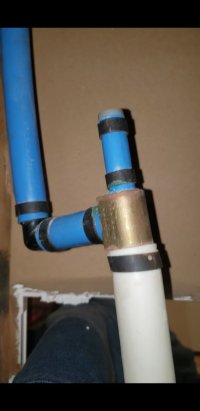I suspect that fitting was what was on the truck. It looks to me as if it creates a "dead leg". Google that.
I see in
https://www.iccsafe.org/wp-content/uploads/IPC-IPSDC.pdf that IPC is considering disallowing "dead legs" in supply line plumbing.
==================
P 111-15
604.4 (New)
Proponent: Ronald George, Self; Plumb-Tech Design & Consulting Services LLC;
www.LegionellaPrevention.org, representing Self; Plumb-
Tech Design & Consulting Services LLC (
Ron@Plumb-TechLLC.com)
2015 International Plumbing Code
Add new text as follows:
604.4 Maximum length of dead leg piping The length of dead legs in the hot or cold water distribution piping systems shall not exceed four branch pipe
diameters.
Reason: The length of the dead leg was determined from examining several glass piping installations with colored water in order to illustrate how stagnant water reacts in piping branches1. In the
testing that I witnessed, the clear water flowing past a branch illustrated that the colored water remained beyond 4 to 5 pipe diameters from the tee. Based on this observation, water treatment
chemicals would be able to reach about 4 pipe diameters into a branch pipe to control Legionella bacteria but not beyond about 4 pipe diameters. For this reason, 4 pipe diameters is an
appropriate maximum distance for dead legs. Longer dead legs would be possible with some form of parralel piping flow or circulation to maintain water treatment chemical levels in branches.
Dead legs are a significant source of Legionella bacteria and other pathogen growth in biofilms in the plumbing system. Dead legs are sections of pipe where water does not normally flow.
Stagnant water in dead legs allows the water treatment chemicals to dissipate, rendering them ineffective for controling Legionella.

